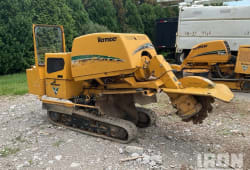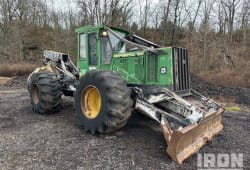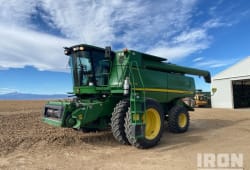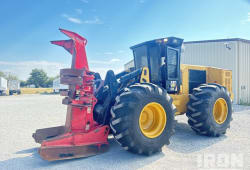Branching Out: The Newest Innovations in Forestry Equipment
9 Lectura mínima
)
enero 18, 2024
Forestry, an industry deeply rooted in tradition, has witnessed a transformative journey with the integration of cutting-edge technologies into its machinery. From sustainable logging practices to improved efficiency in harvesting, the latest innovations in forestry equipment are shaping the future of this vital sector.
Heralding a New Era of Sustainability
Smart Harvesting Techniques
In the quest for sustainable forestry practices, innovations have paved the way for smart harvesting techniques. Modern machinery is equipped with sensors and artificial intelligence to identify optimal times for harvesting, minimizing environmental impact. This ensures that the delicate balance of ecosystems is preserved during the logging process.
Eco-Friendly Power Sources
One notable innovation is the shift towards eco-friendly power sources. Forestry equipment is increasingly powered by electric or hybrid engines, significantly reducing emissions and noise pollution in forested areas. This transition aligns with global efforts to promote sustainability and minimize the ecological footprint of logging operations.
Precision Forestry: A Digital Revolution
Automated Logging Processes
Automation has become a cornerstone of precision forestry, with machinery now capable of automated logging processes. This includes autonomous felling, delimbing, and bucking, allowing for increased efficiency and reduced reliance on manual labor. Automated systems also enhance worker safety by minimizing exposure to hazardous conditions.
Drone Technology for Forest Monitoring
Drones have emerged as valuable tools for forest monitoring. Equipped with advanced sensors, they provide real-time data on forest health, allowing operators to identify diseased or compromised trees quickly. This proactive approach enables timely intervention, preventing the spread of diseases and promoting overall forest well-being.
Technological Integration in Timber Harvesting
High-Tech Logging Equipment
The latest innovations in logging equipment include high-tech solutions such as intelligent saws and harvesters. These forestry equipment use data analytics and computer vision to optimize cutting angles and minimize waste. The result is a more efficient and precise timber harvesting process, contributing to increased productivity.
Telematics for Equipment Management
Telematics, integrated into forestry machinery, offer remote monitoring and diagnostics. Equipment managers can track machine performance, fuel consumption, and maintenance needs in real-time. This data-driven approach enables proactive maintenance, reducing downtime and enhancing overall operational efficiency.
Future Prospects and Challenges
Sustainable Practices as Industry Norms
As these innovations become more prevalent, the forestry industry is transitioning towards a future where sustainable practices are the norm. Stakeholders increasingly recognize the importance of preserving forests for ecological balance, and innovations in machinery play a pivotal role in achieving this delicate equilibrium.
Adapting to Changing Landscapes
While embracing innovation, the industry also faces the challenge of adapting to changing landscapes. Climate change impacts forest ecosystems, necessitating machinery that can withstand evolving environmental conditions. Continuous research and development are vital to ensure forestry equipment remains resilient and effective in the face of these challenges.
Introduction to Cutting-Edge Technologies in Forest Equipment
Forests, crucial components of our planet's ecosystem, are under constant threat from various challenges, including climate change, deforestation, and invasive species. To address these challenges and promote sustainable forest management, the integration of cutting-edge technologies has become paramount. This transformation not only enhances the efficiency of forest management practices but also contributes to the preservation of biodiversity and the mitigation of environmental impacts. In this introduction, we explore cutting-edge technologies revolutionizing forest equipment.
Satellite Imaging and Remote Sensing
One of the most significant advancements in forest management is the utilization of satellite imaging and remote sensing technologies. These tools provide a comprehensive and real-time view of forested areas, allowing for accurate mapping, monitoring, and assessment of forest health. Satellite imagery aids in identifying changes in land cover, deforestation rates, and even subtle variations in vegetation density, enabling informed decision-making.
LiDAR Technology for 3D Mapping
Light Detection and Ranging (LiDAR) technology has revolutionized the way forests are mapped and analyzed. By emitting laser pulses from aircraft or drones, LiDAR creates high-resolution, three-dimensional maps of forested landscapes. This technology enables detailed assessments of canopy structure, tree heights, and terrain, providing invaluable data for forest inventory, carbon sequestration estimates, and ecosystem modeling.
Big Data Analytics and Machine Learning
The vast amount of data generated from satellite imagery, LiDAR scans, and other sources is harnessed through big data analytics and machine learning algorithms. These technologies process and analyze data at an unprecedented scale, offering insights into complex forest dynamics. Machine learning models can predict forest disturbances, identify potential disease outbreaks, and optimize forest management strategies based on historical and real-time data.
Geographic Information Systems (GIS)
Geographic Information Systems (GIS) play a pivotal role in forest management by integrating spatial data to create comprehensive maps. GIS technology enables forestry professionals to overlay diverse datasets, such as topography, soil composition, and wildlife habitats. This spatial analysis aids in identifying optimal locations for logging operations, planning conservation areas, and understanding the interconnectedness of ecosystems.
Smart Forest Inventory Management
Traditional forestry equipment methods are being replaced by smart inventory management systems that incorporate RFID (Radio-Frequency Identification) tags, GPS trackers, and mobile applications. These technologies streamline the process of tracking individual trees, monitoring growth rates, and assessing timber volumes. Smart inventory management ensures accurate data collection and supports sustainable harvesting practices.
Sensor Networks and Internet of Things (IoT)
Deploying sensor networks and Internet of Things (IoT) devices in forests enhances real-time monitoring and data collection. These sensors can measure environmental variables such as temperature, humidity, and soil moisture. The collected data aids in assessing the impact of climate change, predicting wildfire risks, and implementing adaptive management strategies.
In this era of rapid technological advancement, the synergy between cutting-edge technologies and forest management is pivotal for creating resilient, sustainable ecosystems. These innovations empower forest managers with unprecedented insights, allowing them to make informed decisions that balance human needs with the preservation of our invaluable forests.
Types of forestry equipment used for tree harvesting and removal.
In the vast realm of forestry, the efficient harvesting and removal of trees require specialized equipment tailored to various tasks. Let explore the diverse types of forestry equipment essential for tree harvesting and removal, shedding light on the machinery that plays a pivotal role in sustainable forestry practices.
1. Chainsaws: The Timber Tamer Chainsaws are the quintessential tool for felling trees and cutting them into manageable sections. Modern chainsaws come in various sizes and power capacities, allowing foresters to adapt to different tree species and sizes.
2. Harvesters: The Precision Woodcutters Harvesters are highly mechanized machines designed for felling, delimbing, and cutting trees into logs. Equipped with advanced technology, these machines significantly increase efficiency in large-scale forestry operations.
3. Forwarders: The Timber Transporters Forwarders are specialized vehicles used to transport felled trees from the harvesting site to a landing or roadside for further processing. They come in various sizes, accommodating different load capacities and terrain conditions.
4. Skidders: The Lumber Haulers Skidders are powerful machines designed to drag felled trees from the harvest site to a central location. They excel in navigating challenging terrains, making them indispensable in rugged forestry environments.
5. Feller Bunchers: The Tree Grapplers Feller bunchers are mechanized marvels that simultaneously cut and grab multiple trees, streamlining the harvesting process. These machines are particularly efficient in clear-cutting operations.
6. Mulchers: The Vegetation Management Specialists Mulchers are used for clearing vegetation, including small trees and brush, to prepare an area for planting or other land management activities. They are essential for maintaining healthy and productive forest ecosystems.
7. Log Loaders: The Tree Stackers Log loaders are heavy-duty machines designed to handle and load logs onto trucks for transportation. They are equipped with grapples and booms to efficiently lift and stack logs of varying sizes.
8. Cranes: The Precision Handlers Forestry Equipment cranes are versatile machines used for various tasks, such as loading logs onto trucks, placing logs in sorting yards, and assisting in the assembly of logging equipment. Their adaptability makes them indispensable in forestry operations.
9. Chipper Machines: The Waste Converters: Chippers are employed to process leftover branches and debris into wood chips or mulch. This sustainable practice minimizes waste and repurposes material for other applications, such as landscaping.
10. Stump Grinders: The Root Removers Stump grinders are essential for removing tree stumps after harvesting. They grind the stump into wood chips, eliminating obstacles and promoting land regeneration.
Conclusion
In conclusion, the latest innovations in forestry equipment mark a significant shift towards sustainable, efficient, and technologically advanced practices. As the industry continues to embrace these changes, it is poised to strike a harmonious balance between meeting the global demand for wood products and preserving our invaluable forests for generations to come. The journey of branching out into innovation ensures that forestry remains not just an industry but a steward of our planet's green lungs.
Sustainable forest management is at the forefront of global environmental initiatives, aiming to balance the economic benefits of forestry with the conservation of natural ecosystems. From precision harvesting to eco-friendly waste management, these forest equipment are essential for maintaining the delicate equilibrium between human needs and environmental preservation. Modern forestry equipment is often integrated with advanced technology, enabling real-time monitoring and data collection. This data-driven approach aids foresters in making informed decisions

Caleb Woods is an experienced content specialist and an editor at Boom & Bucket, blending his journalism background with expertise in the heavy equipment industry. He delivers engaging, informative content to help professionals stay informed and make smarter decisions in the machinery market.














